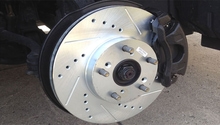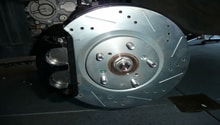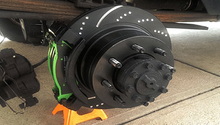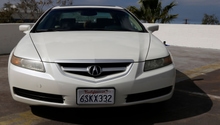Acura MDX: Brake Modifications
The Acura MDX is by no means a track oriented vehicle, but for some owners nothing stock stays very long, so the brakes get modded along with everything else. Read on for aftermarket brake upgrades that will stop faster and look better under your custom wheels.
This article applies to the Acura MDX (2007-2015).
The OEM four wheel disc brake setup fitted to the Acura MDX does an adequate job of stopping the vehicle for most people, but it can always be better. Some owners using their MDX in severe conditions, like towing or the occasional spirited drive through the twisties, will quickly find the limits of the factory setup. While the MDX is not considered a performance car by any stretch, it does not mean that a spongy brake pedal or pulsing brake rotors are acceptable. A variety of brake system upgrades are available and can be completed in stages to take braking performance up a notch. The best part is that the upgraded brake components are normal service items, so you can complete each upgrade as necessary. The following article will outline some of the common brake upgrades that can be installed on the Acura MDX.
Basic Brake Upgrades
Braking performance can often be greatly improved by installing a few simple upgraded components.
HIgh Temp Brake Fluid
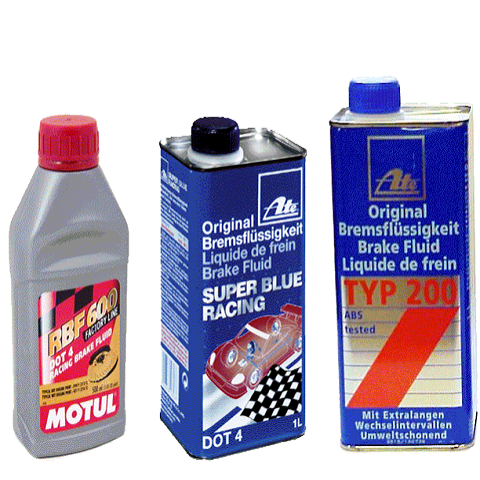
DIY Cost – $40-80
Professional Cost – $110-150 (depending on fluid choice)
Skill Level – Easy; a brake fluid flush can be easily accomplished at home without the need of any special tools.
Perhaps the first item for any owner looking to improve the brakes on their MDX is upgraded brake fluid. You should flush your old fluid every other year anyway, so why not use better stuff? The brake system on most new vehicles come filled with cheap DOT 3 brake fluid that has a dry boiling point of approximately 400° F. Under spirit driving situations where the brakes are heavily used, downhill twisty roads in the mountains for instance, the brakes generate additional heat that may boil the brake fluid and cause brake fade. Simply replacing the brake fluid with a high performance DOT 3 or 4 fluid, such as Castrol SRF or Motul RBF600, will allow for heavy brake usage without brake fade. A high performance brake fluid can have a dry boiling point of nearly 600° F.
Pro Tip
Over time, brake fluid will absorb moisture and effectively reduce the boiling point of the fluid (wet boiling point). Brake fluid will generally reach its wet boiling point at approximately two years after being put into service; hence, why most manufacturers recommend a 2-year brake fluid flush interval.
(Related Article: How to Replace Brake Fluid - AcuraZine.com)
Performance Brake Pads
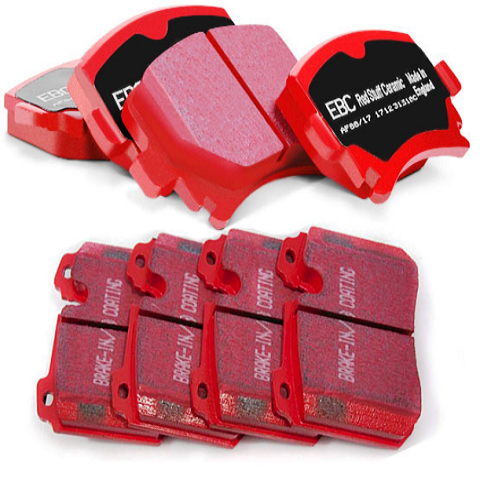
DIY Cost – $80-150
Professional Cost – $175-350
Skill Level – Easy; a relatively simple maintenance procedure that can be accomplished with basic tools.
Although upgraded brake pads are listed as a basic upgrade, they can make a tremendous improvement in braking performance. The OEM pads fitted to the MDX are a compromise, designed to be very quiet and not produce much brake dust. Aftermarket pads will have a much more aggressive initial bite, and most will continue to grab as they get hot, long past where the stock pads have given up. A set of performance pads will have an increased coefficient of friction for improved stopping power, while also being able to dissipate heat and cut down on brake fade. While performance brake pads will have the most noticeable improvement when coupled with performance brake rotors, a new set of pads alone can transform the driving experience, especially if your brake pads are due for replacement anyway.
(Related Article: How to Replace Brake Pads/Calipers/Rotors - AcuraZine.com)
Intermediate Brake Upgrades
While not necessarily hard to install or expensive, these intermediate brake upgrades will take braking performance to the next level.
Braided Stainless Steel Brake Lines

DIY Cost – $90-120
Professional Cost – $200-$240
Skill Level – Easy; swapping brake lines is a simple tasks that only requires a brake bleed once completed.
Most manufacturers use flexible rubber brake lines because they are inexpensive, often 1/5th the price of a braided line. Brake fluid travels the length of the vehicle through thin, rigid steel lines to the area near each wheel, where the suspension and steering components work. Without a flexible hose, there should be no way to have brakes on wheels that steer, or move with the suspension. The problem with the OEM rubber brake hoses is that they expand as the brakes are used, leading to a spongy brake pedal. Braided stainless steel brake lines encase a Teflon brake hose in a tightly woven steel fabric that will not allow expansion as the brakes are used. With brake system pressures exceeding 1,000 PSI, it is easy to see where the OEM hoses fall short. Even with no other changes, braided hose will give you better feel at the brake pedal, and transfer more of your pedal effort into braking.
(Related Article: How to Replace Brake Line - AcuraZine.com)
Performance Rotors
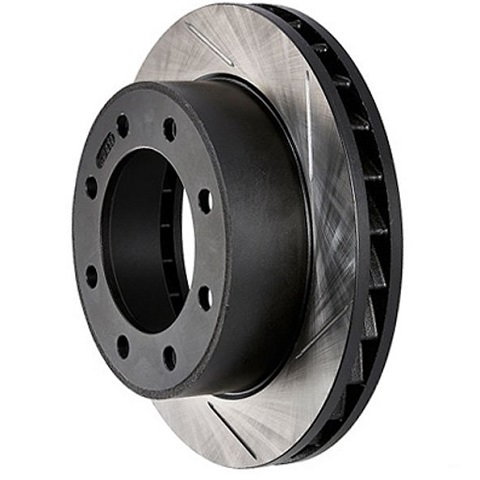
DIY Cost – $50-120 per rotor
Professional Cost – $250-500 per axle
Skill Level – Moderate; a bit more complicated than a brake pad change, but fairly easy if you have a basic knowledge of the brake system.
A number of owners have experienced warped brake rotors on their MDX and have turned to the aftermarket for their brake rotor needs. Many aftermarket rotors feature drilled and slotted surfaces to reduce gas, dust, water, and heat build-up between the pads and rotors that typically accompany traditional solid rotors. These rotors tend to run at cooler temperatures and are less susceptible to brake fade, and subsequent rotor warping, when used in extreme conditions. As previously mentioned, a set of slotted/drilled rotors coupled with performance brake pads will net the most noticeable improvement in braking performance. For some owners, especially if they have custom wheels, the drill holes and slots just add a nice aesthetic touch as well.
Advanced Brake Upgrades
For all out braking performance, ditch the OEM brake components in favor of race inspired hardware.
Big Brake Kits
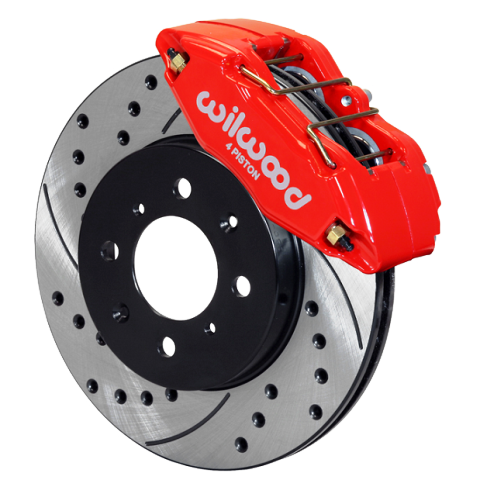
DIY Cost – $650-1,500
Professional Cost – $1,000-2,000
Skill Level – Difficult; although installation of brake components is straightforward, fabrication of a caliper adapter requires fabrication tools and skills.
While most of the brake upgrades listed above will be adequate for 99% of MDX owners, a BBK (Big Brake Kit) will give those select few the biggest, baddest, and best performing brake system on the market. A BBK typically incorporates new larger diameter performance rotors, brake pads, braided stainless brake lines, and larger 4-piston brake calipers for more stopping power. Although most manufacturers will include nearly all the components necessary to beef up your brakes, the MDX is a fairly uncommon recipient of a BBK, so it is left to the individual to fabricate their own brake caliper adapter to mount the larger calipers in the OEM locations. Overall, this type of brake setup is as good as it gets, and looks even better, especially when paired with a set of over-sized custom wheels.
Pro Tip
Whenever upgrading brake system components, it is also worth considering suspension and tire upgrades. Suspension geometry can vary under extreme braking situations and cause stability issues. Similarly, a better performing tire with higher levels of grip will be able to transmit more braking force to the ground without lock-up
Related Discussions
- MDX Brake Replacement - What Are the Best Parts? - AcuraZine.com
- Looking for a Performance Brake System 2012 MDX - AcuraZine.com
- Rotor and Front Pads Recommendation - AcuraZine.com

